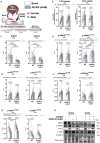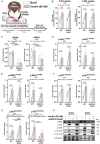Muscle-specific AXIN1 and AXIN2 double knockout does not alter AMPK/mTORC1 signalling or glucose metabolism
- PMID: 40587294
- PMCID: PMC12320205
- DOI: 10.1113/JP288854
Muscle-specific AXIN1 and AXIN2 double knockout does not alter AMPK/mTORC1 signalling or glucose metabolism
Abstract
AMP-activated protein kinase (AMPK) and mechanistic target of rapamycin complex 1 (mTORC1) are crucial kinase signalling hubs that regulate the balance between catabolism and anabolism in skeletal muscle. The scaffold protein AXIN1 has been proposed to regulate the switch between these pathways and be required for GLUT4 translocation in skeletal muscle and adipocyte cell lines. Muscle-specific AXIN1 knockout (KO) mice exhibit no discernable phenotype, possibly due to compensation by AXIN2 upon AXIN1 loss. Thus we generated and characterized muscle-specific inducible AXIN1 and AXIN2 double knockout (dKO) mice. Surprisingly AXIN1/2 dKO mice displayed normal AMPK and mTORC1 signalling and glucose uptake in response to 5-aminoimidazole-4-carboxamide ribonucleotide (AICAR), insulin and in situ muscle contraction. These findings suggest that AXIN proteins are not essential for the regulation of AMPK and mTORC1 signalling or glucose uptake in skeletal muscle. This study challenges the previously indicated critical roles of AXIN1 in exercise-stimulated AMPK activation and GLUT4-mediated glucose uptake in skeletal muscle. KEY POINTS: Phenotyping of tamoxifen-inducible muscle-specific AXIN1/2 double knockout (dKO) mice. We find no evidence for AXIN-dependent AMPK or mTORC1 regulation in skeletal muscle by insulin, AMPK activation or contraction. Glucose uptake regulation by insulin and AMPK activation is normal in AXIN1/2 dKO mice.
Keywords: AMPK; exercise; glucose transport; mTOR; skeletal muscle.
© 2025 The Author(s). The Journal of Physiology published by John Wiley & Sons Ltd on behalf of The Physiological Society.
Conflict of interest statement
The authors declare that they have no competing interests.
Figures




References
-
- González, A. , Hall, M. N. , Lin, S. C. , & Hardie, D. G. (2020). AMPK and TOR: The yin and yang of cellular nutrient sensing and growth control. Cell Metabolism, 31(3), 472–492. - PubMed
-
- Henríquez‐Olguin, C. , Knudsen, J. R. , Raun, S. H. , Li, Z. , Dalbram, E. , Treebak, J. T. , Sylow, L. , Holmdahl, R. , Richter, E. A. , Jaimovich, E. , & Jensen, T. E. (2019). Cytosolic ROS production by NADPH oxidase 2 regulates muscle glucose uptake during exercise. Nature Communications, 10(1), 4623. - PMC - PubMed
-
- Huraskin, D. , Eiber, N. , Reichel, M. , Zidek, L. M. , Kravic, B. , Bernkopf, D. , von Maltzahn, J. , Behrens, J. , & Hashemolhosseini, S. (2016). Wnt/β‐catenin signaling via Axin2 is required for myogenesis and, together with YAP/Taz and Tead1, active in IIa/IIx muscle fibers. Development (Cambridge, England), 143(17), 3128–3142. - PubMed
MeSH terms
Substances
Grants and funding
LinkOut - more resources
Full Text Sources
Research Materials
Miscellaneous
